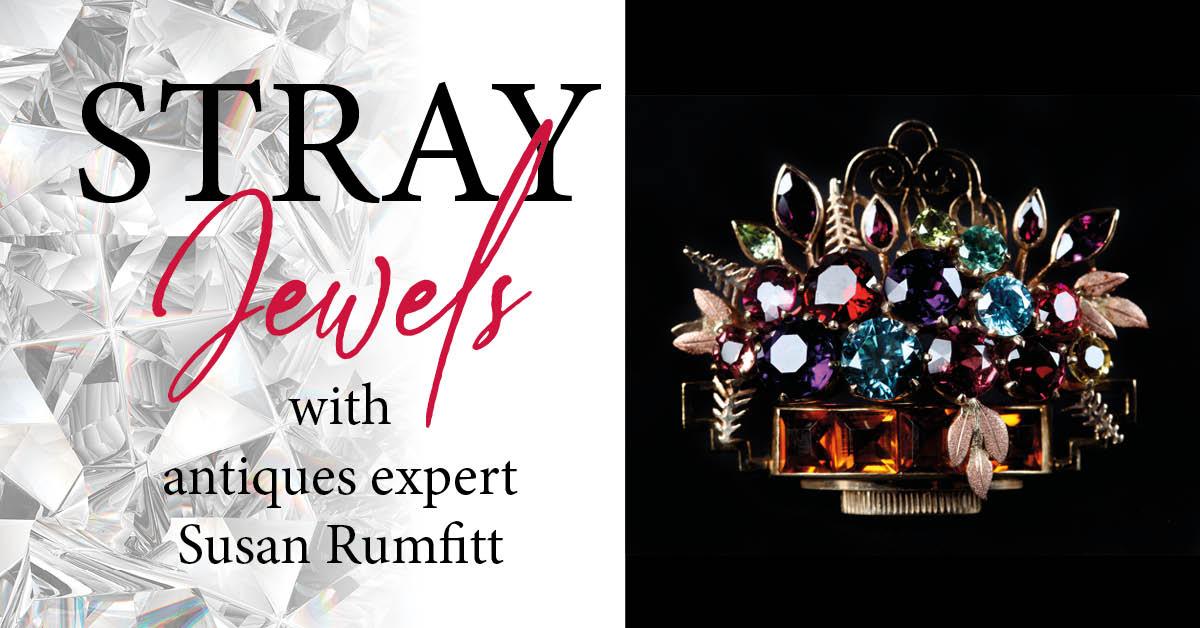Subscribe to trusted local news
In a time of both misinformation and too much information, quality journalism is more crucial than ever. By subscribing, you can help us get the story right.
- Subscription costs less than £1 a week with an annual plan.
Already a subscriber? Log in here.
25
Apr 2021
Stray Jewels with Susan Rumfitt: Art Deco Delights


 Stray Jewels is a monthly column written by BBC Antiques Roadshow jewellery specialist, Susan Rumfitt. Susan started her career working for Christie’s auctioneers in Glasgow before establishing her own jewellery department, The Gallery in Harrogate. In 2006, she joined the Antiques Roadshow and has since built up an extensive knowledge of and passion for fine jewellery. This week Susan takes a closer look at Art Deco jewellery, including how it developed and the key influencers.
Stray Jewels is a monthly column written by BBC Antiques Roadshow jewellery specialist, Susan Rumfitt. Susan started her career working for Christie’s auctioneers in Glasgow before establishing her own jewellery department, The Gallery in Harrogate. In 2006, she joined the Antiques Roadshow and has since built up an extensive knowledge of and passion for fine jewellery. This week Susan takes a closer look at Art Deco jewellery, including how it developed and the key influencers.
I have been really looking forward to getting back on the road and viewing auctions and visiting antique shops. I didn’t have to venture too far from The Gallery for my first trip out, just around the corner to Morphets Auctioneers, whose Fine Art Sale included just over 150 lots of jewellery and didn’t fail to disappoint.
The jewellery was from two private estates and featured a whole range of jewellery including Georgian, Edwardian contemporary Scandinavian and 1970’s jewellery. One of the private collections was full of Art Deco pieces and the proceeds of the collection were going to St Gemma’s Hospice in Leeds.
Art Deco continues to be one of the most collected styles in Jewellery. It is bold in design, exquisite in execution and although only spanning the 1920’s and 30’s it is timeless. The visual appeal of the period was seen in the Great Gatsby film and of course Downton Abbey, both productions raising the popularity of the style.
How did the style develop?
The style came after the more delicate Edwardian period. Following the first world war fashion became bolder and jewellery needed to follow suit. Lot 329- A Sapphire and Diamond Ring, shows the transition from delicate to a more geometric design. This ring sold for £950. A more bold and solid approach to design, was reflected in lot 343- An Art Deco Diamond Plaque Ring. Many people re designed their jewels in the Art Deco period and this ring is a typical example, set with old European cut diamonds, dating from the 1890s but within a 1920’s mount. This beautiful ring sold for £1,000.
Characteristics of the Art Deco Style
Colour contrasts, geometric shapes, asymmetrical designs and big compositions. This was represented in a number of lots in the sale. In particular lot 299, A Pair of Diamond Dress Clips c1935 which sold for £2,400. The double clips which can be worn as one brooch or separated and worn on jacket lapels incorporated brilliant-cut and baguette-cut diamonds, round and oblong respectively.
The idea of incorporating such different cuts was to bring variety and movement to the solid composition. The modern brilliant-cut diamond developed in the 1920’s brings more brilliance to the diamond with more facets than had ever been seen before. Lot 315- An Art Deco Emerald and Diamond Cluster Ring which sold for £3,000, and Lot 365- An Art Deco Ruby and Diamond Cluster Ring which sold for £1,500 both emphasise the passion for big statement rings during this period.
Jewellery Designers and Influences
Cartier, Boucheron, Van Cleef & Arpels are amongst the most well known fine jewellers of the period. The sale featured a couple of pieces by the less well known firm Alabaster and Wilson, a family run firm founded in 1887 and based in Birmingham. They were asked by the Racing Post to make a diamond and enamel racing horse brooch for Her Majesty the Queen’s 90th Birthday – a great honour. Lot 302 in the sale, The Jardiniere (basket of flowers) Brooch, was made by them and sold for £550.
Jardiniere brooches had been made popular by Cartier and as a result jewellers were quick to produce their own interpretations of the theme. This brooch was dated circa 1935 and shows how by this time more semi-precious stones such amethysts, garnets, citrines and peridots were being used in jewellery. These stones continued to be incorporated into jewellery throughout the 1940’s and 50’s and jewellery design also continued to feature some of the characteristics of Art Deco Jewellery.
I absolutely loved this piece, an abundance of colour in a basket! Summer really is just around the corner.
Read More:
- Stray Jewels with Susan Rumfitt: the timeless allure of pearls
- Stray Jewels with Susan Rumfitt: Amethyst and Aquamarine
0